
The following is my review of the Akasa Venom A20 240mm AIO water cooling unit. The unit was kindly provided by OcUK for the purpose of this review. I will apologise now, there are lots of images so spoiler tags have been used liberally.
OcUK Product Page - https://www.overclockers.co.uk/akasa-venom-a20-dual-radiator-liquid-cpu-cooler-hs-104-ak.html
Akasa Product Page - http://www.akasa.com.tw/search.php?seed=AK-LC4002HS01
Specifications
• Radiator dimensions: 272 x 120 x 27mm
• PUMP input voltage: DC 12V
• Tube length: 320mm
• Tube diameter: Ø 12mm
• Fan dimensions: 120 x 120 x 25mm
• Fan speed: 600-1900 RPM
• Fan Max airflow: 83.63 CFM
• Fan Max air pressure: 2.98 mmH2O
• Fan Noise level: 6.9-28.9 dB(A)
• PUMP input voltage: DC 12V
• Tube length: 320mm
• Tube diameter: Ø 12mm
• Fan dimensions: 120 x 120 x 25mm
• Fan speed: 600-1900 RPM
• Fan Max airflow: 83.63 CFM
• Fan Max air pressure: 2.98 mmH2O
• Fan Noise level: 6.9-28.9 dB(A)
Key Features
• All-in-one liquid cooler design for easy installation
• High precision CNC Copper base for high efficiency heat transfer
• New low noise 4-pole pump reduces vibration
• Durable large diameter tubes provide smooth and quiet flow
• Reinforced four-layer tube
• Low noise Viper fan with S-FLOW blades
• Award winning S-FLOW fans provides 30% more airflow
• Integrated white LED indicator
• Oxygen-free copper base
• High Density FPI (fins per inch) radiator for rapid heat transfer
• Integrated white LED indicator
• 2 Year Warranty
• High precision CNC Copper base for high efficiency heat transfer
• New low noise 4-pole pump reduces vibration
• Durable large diameter tubes provide smooth and quiet flow
• Reinforced four-layer tube
• Low noise Viper fan with S-FLOW blades
• Award winning S-FLOW fans provides 30% more airflow
• Integrated white LED indicator
• Oxygen-free copper base
• High Density FPI (fins per inch) radiator for rapid heat transfer
• Integrated white LED indicator
• 2 Year Warranty
Packaging
The Venom A20 comes well packaged, the box is sturdy and nicely printed to convey the products features and specifications. Upon opening the box, the contents are individually wrapped and neatly held in place by the card insert.


Contents & First Impressions
The A20 kit consists of:
• The Venom A20 cooler itself.
• Two Akasa Viper 120mm fans.
• The mounting hardware required for both Intel and AMD sockets:
• A Molex to 4 pin cable.
• Akasa thermal compound.
• An excellent installation manual.
The unit itself feels well-built and about as robust as you could reasonably expect in this price range. Like many other models, the A20 features an LED back-lit pump top, however, the brightly coloured Viper fans help it stand out from the competition. Although, if you are averse to yellow this could land on the ‘cons’ list.
The copper base plate looks to be good quality and I was pleased at the lack of pre-applied thermal compound as I would have only removed it to apply my own. There were a couple of bent fins on the radiator, however, I would consider this par for the course and certainly within a QC tolerance. I would also like to note that the tubing seems of superior quality and strength to that in use on my previous AIO (Asetek 240mm).
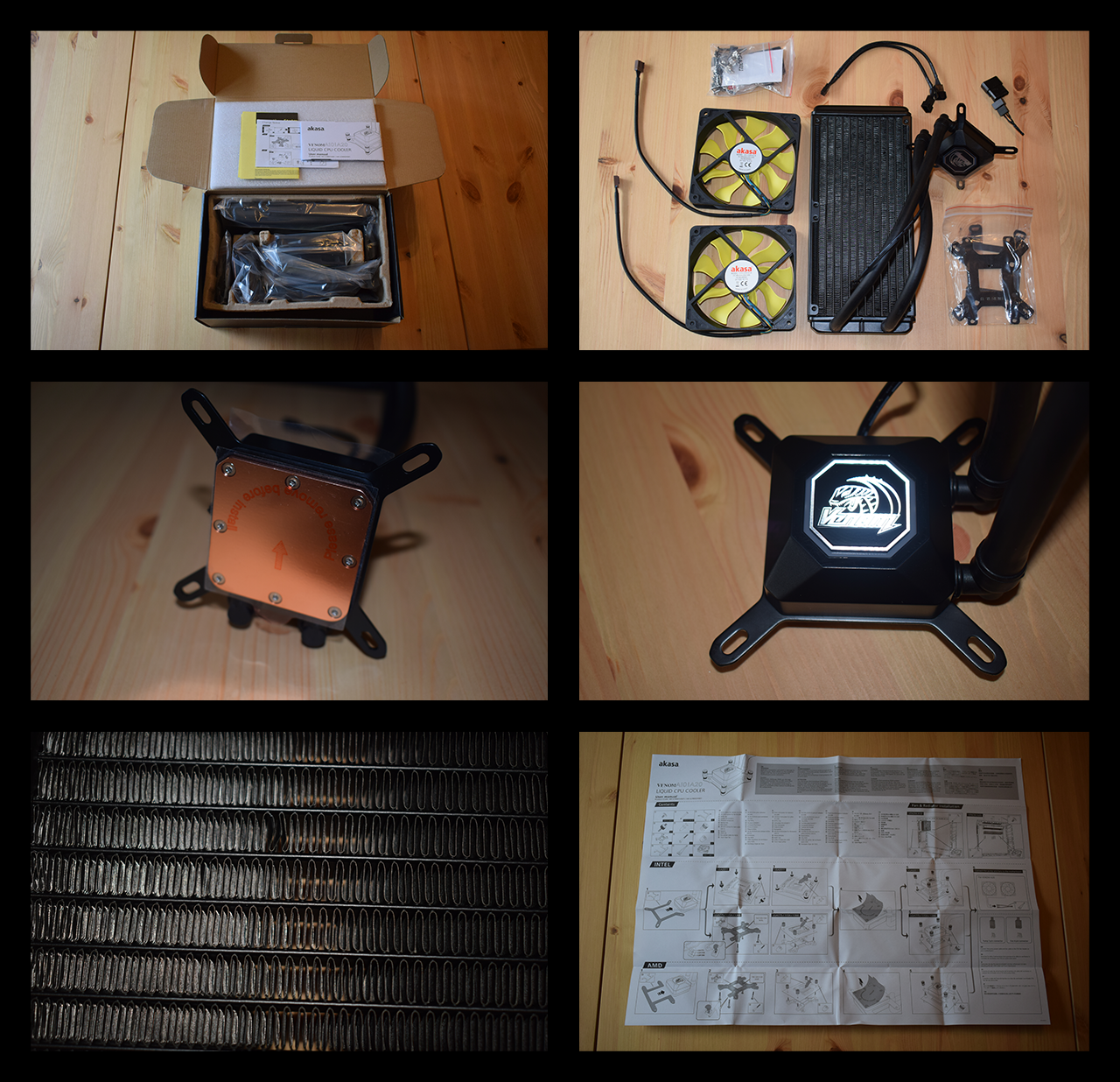
• The Venom A20 cooler itself.
• Two Akasa Viper 120mm fans.
• The mounting hardware required for both Intel and AMD sockets:
o Intel – LGA775, LGA115X, LGA1366 & LGA2011
o AMD – AM2, AM2+, AM3, AM3 +, FM1 & FM2
• A 4 pin fan splitter cable.• A Molex to 4 pin cable.
• Akasa thermal compound.
• An excellent installation manual.
The unit itself feels well-built and about as robust as you could reasonably expect in this price range. Like many other models, the A20 features an LED back-lit pump top, however, the brightly coloured Viper fans help it stand out from the competition. Although, if you are averse to yellow this could land on the ‘cons’ list.
The copper base plate looks to be good quality and I was pleased at the lack of pre-applied thermal compound as I would have only removed it to apply my own. There were a couple of bent fins on the radiator, however, I would consider this par for the course and certainly within a QC tolerance. I would also like to note that the tubing seems of superior quality and strength to that in use on my previous AIO (Asetek 240mm).

Installation
Installing the unit was a pain free and pleasant experience. This I’m sure is partially due to the fact that I am running on x99 with the LGA2011 socket, this meant that no additional back plates or brackets were required. Additionally, the installation manual for the cooler was clear, concise and printed in a large enough format that I could glance at it from across the desk as I worked.
In this instance the cooler attaches to the CPU with 4 easy steps:
1. Install the 4 standoff screws directly to the motherboard.
2. Add thermal compound to your CPU.
3. Apply the cooler to the CPU so that it fits neatly over the stand offs.
4. Install the 4 thumbscrews to the cooler unit in order to hold it in place.
Installation of the radiator was just as simple. I installed the fans in a push configuration taking in cool air from outside the case. I did this in most part because this was how my previous cooler was installed and I wanted to give the fairest comparison I could between the two.
Once you have the radiator and CPU block installed it is a simple case of plugging in the pump and 4 pin fan connectors.
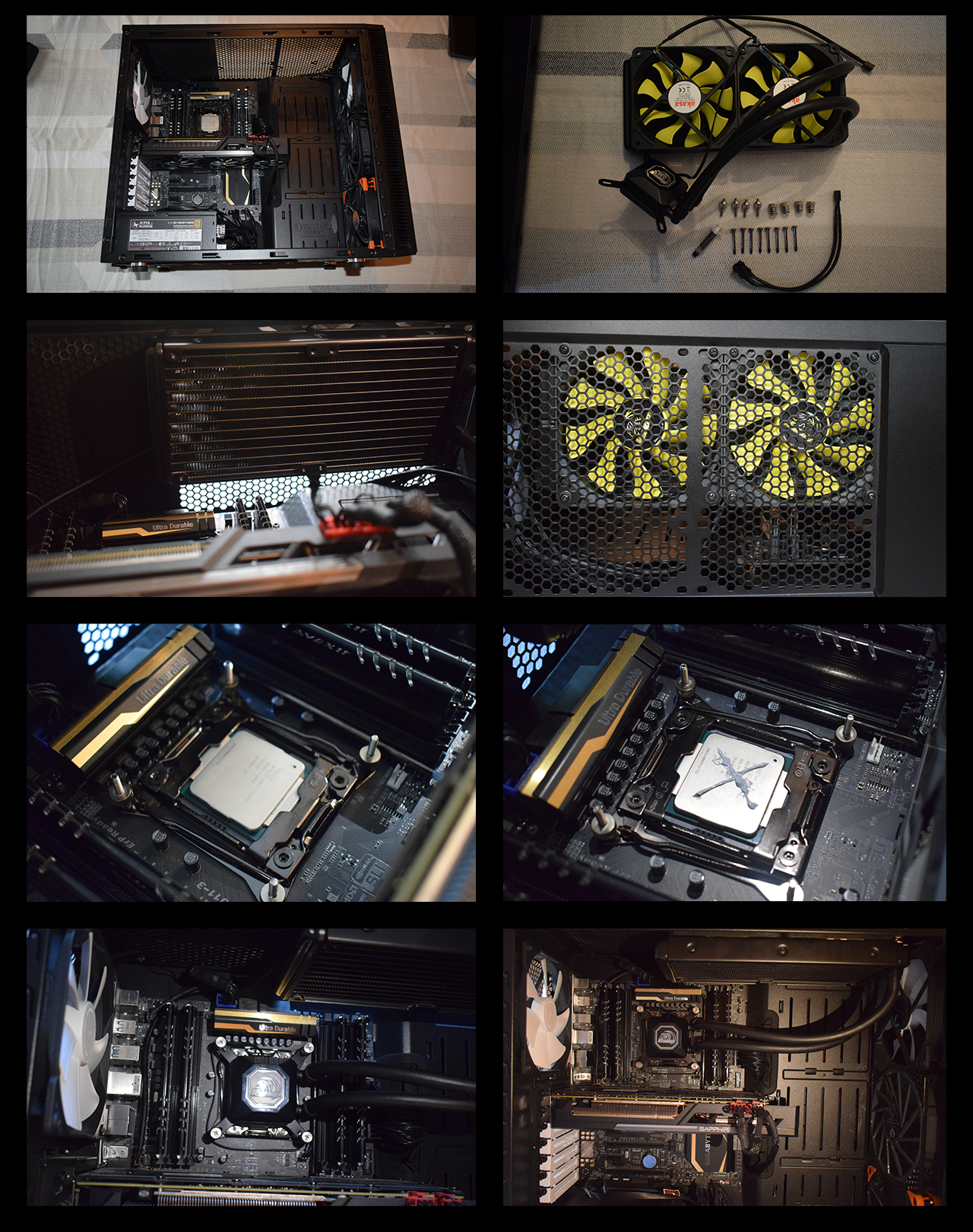
In this instance the cooler attaches to the CPU with 4 easy steps:
1. Install the 4 standoff screws directly to the motherboard.
2. Add thermal compound to your CPU.
3. Apply the cooler to the CPU so that it fits neatly over the stand offs.
4. Install the 4 thumbscrews to the cooler unit in order to hold it in place.
Installation of the radiator was just as simple. I installed the fans in a push configuration taking in cool air from outside the case. I did this in most part because this was how my previous cooler was installed and I wanted to give the fairest comparison I could between the two.
Once you have the radiator and CPU block installed it is a simple case of plugging in the pump and 4 pin fan connectors.

Testing & Results
I decided to perform a number of tests on the cooler, one stress test using RealBench and three games. I chose games I usually play to give an overview of the performance which can be expected day to day, these were Battlefield 4, Overwatch and Ashes of the Singularity. All games were run at 1080p with a target framerate between 100 and 144hz, both the games and RealBench were run for 30 minutes. I also ran a single pass of the Ashes benchmark in order to stress the CPU more heavily.
Prior to testing I removed my old cooler (OcUK Tech Labs Asetek 240mm unit - https://www.overclockers.co.uk/ocuk...-liquid-cooling-upgrade-bundle-bu-097-tl.html), ensured it was dust free and applied new thermal paste so that the comparison was as fair as I could make it. During testing I recorded ambient room temperatures using a digital thermometer. All CPU usage and temperature data was recorded using HW Info 64. The cooler fans were run on the motherboards balanced profile via the CPU OPT fan header.
For reference, the computer specification this cooler was tested on is as follows:
i7 5820k@4ghz, 1.07v
Sapphire R9 390 Nitro
Gigabyte X99 SLI
16gb Avexir 2400mhz
Crucial M550 256GB SSD
SuperFlower 650W PSU.
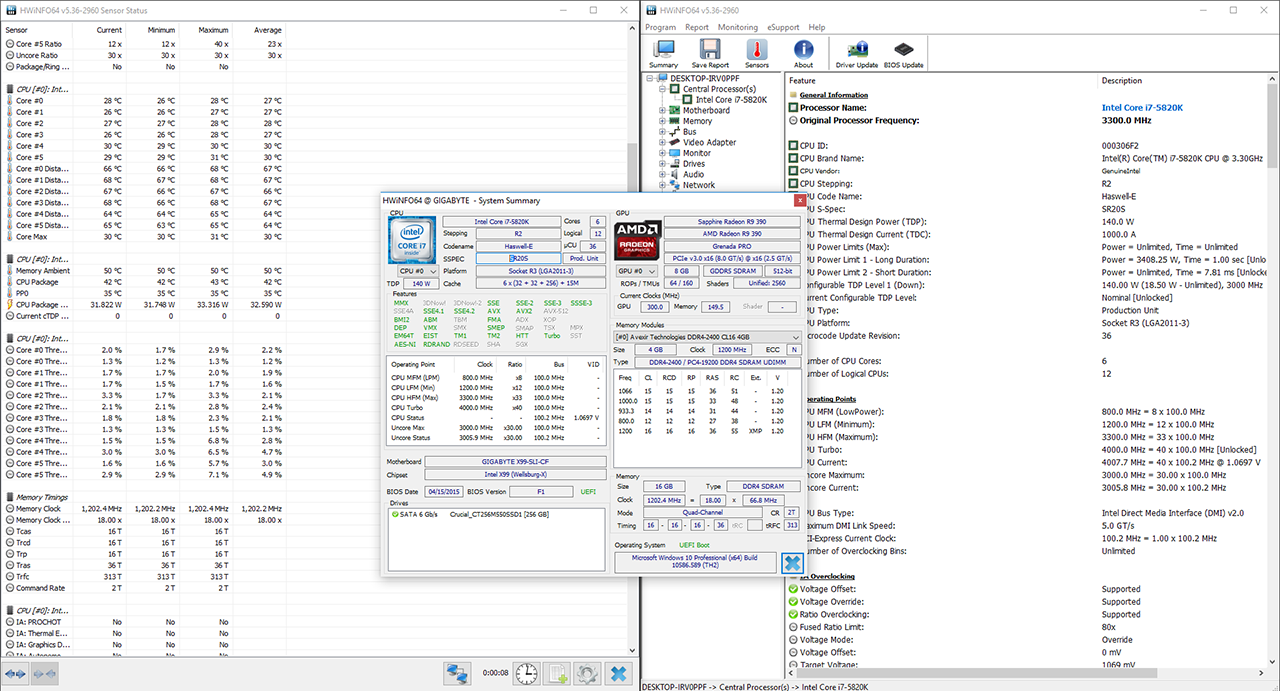
Below are my test results, the graphs represent the max core temperature and average core temperatures achieved over each test compared to the room temperature at the time.
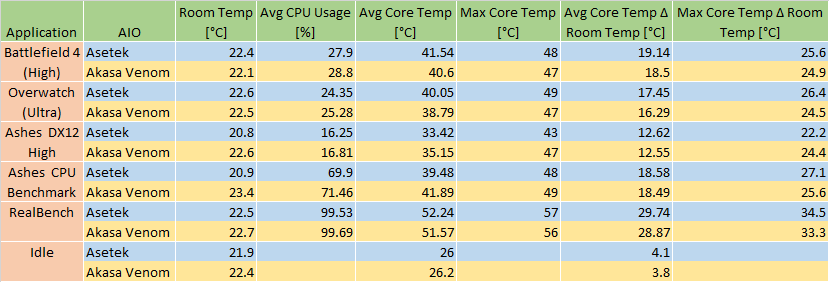
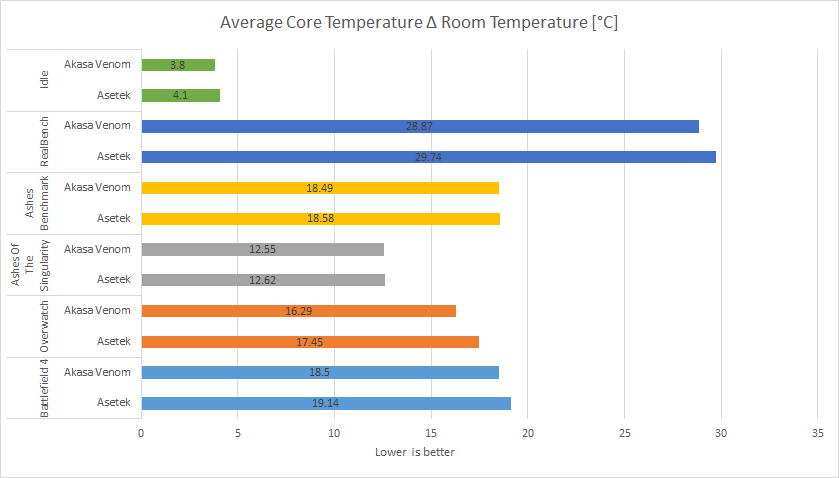
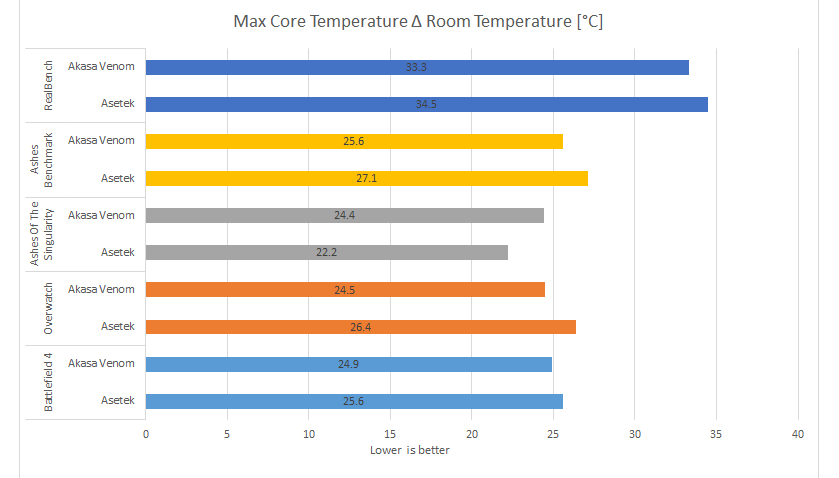
The Akasa Venom A20 did a great job of keeping the CPU cool, even during RealBench and nigh on 100% utilisation the highest core temperature recorded was 56°C, a delta of just 33.3°C from room temperature. All the while the fans on the cooler never exceeded a gentle hum and were certainly inaudible when compared to my case and GPU fans during gaming (these are controlled via speedfan and react to the GPU temperature). Average core temperatures during gaming never exceeded the low 40s and I am comfortable that should I decide to increase the CPU overclock that the cooler would handle it with ease.
The A20 beat out my Asetek unit in all tests bar the Ashes of the Singularity Max Core Temp and I am putting this down to a blip as the CPU load spikes here to around 50% which is around 3 times the average for the test period. In all cases the difference between the two coolers is approximately 0 to 2°C.
Prior to testing I removed my old cooler (OcUK Tech Labs Asetek 240mm unit - https://www.overclockers.co.uk/ocuk...-liquid-cooling-upgrade-bundle-bu-097-tl.html), ensured it was dust free and applied new thermal paste so that the comparison was as fair as I could make it. During testing I recorded ambient room temperatures using a digital thermometer. All CPU usage and temperature data was recorded using HW Info 64. The cooler fans were run on the motherboards balanced profile via the CPU OPT fan header.
For reference, the computer specification this cooler was tested on is as follows:
i7 5820k@4ghz, 1.07v
Sapphire R9 390 Nitro
Gigabyte X99 SLI
16gb Avexir 2400mhz
Crucial M550 256GB SSD
SuperFlower 650W PSU.

Below are my test results, the graphs represent the max core temperature and average core temperatures achieved over each test compared to the room temperature at the time.



The Akasa Venom A20 did a great job of keeping the CPU cool, even during RealBench and nigh on 100% utilisation the highest core temperature recorded was 56°C, a delta of just 33.3°C from room temperature. All the while the fans on the cooler never exceeded a gentle hum and were certainly inaudible when compared to my case and GPU fans during gaming (these are controlled via speedfan and react to the GPU temperature). Average core temperatures during gaming never exceeded the low 40s and I am comfortable that should I decide to increase the CPU overclock that the cooler would handle it with ease.
The A20 beat out my Asetek unit in all tests bar the Ashes of the Singularity Max Core Temp and I am putting this down to a blip as the CPU load spikes here to around 50% which is around 3 times the average for the test period. In all cases the difference between the two coolers is approximately 0 to 2°C.
Summary / TLDR
The Akasa Venom A20 is well priced (on OcUK at least – I have seen a number of sellers retailing these units for a lot more) and it offers a great deal for your money. In my experience the cooler is easy to install and once in looks great. The white LED pump top is a nice feature, although, the fans could be a bridge too far if you are working with a specific colour scheme. Build quality on the unit feels good overall and the tubing does seem very robust, I also liked the inclusion of a PWM splitter and 4pin to Molex cable to give you plenty of cabling options.
The fans stayed quiet during my test, although I cannot offer a tangible measurement here, and I noticed no pump noise over the usual quiet hum of the PC. The A20 did a great job of cooling the CPU and I cannot see any solution in this price range being able to do much, if any, better.
Overall I would give the cooler 8/10; the only things that let it down were some bent radiator fins out of the box and the short length of the screws for attaching the fans to the radiator – I actually ended up using slightly longer screws from my previous cooler to allow me to install the unit in my desired configuration.
I hope that this review is of interest/use to you guys and would be happy to run some further tests should you like.
Thanks for reading,
Jonny L
Last edited:


